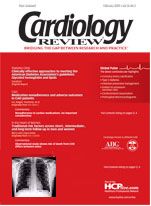Publication
Article
Cardiology Review® Online
Case report: Statins in peripheral artery disease
A 72-year-old man had been treated in our department for more than 10 years for various clinical manifestations of generalized atherosclerotic disease. His cardiovascular risk factors were a 40-year history of smoking, although he had discontinued smoking 2 years earlier; impaired glucose tolerance, with a glycosylated hemoglobin level of about 7%; and well-controlled arterial hypertension (by use of a beta blocking agent, diuretics, and an angiotensin-converting enzyme inhibitor). The patient had no lipid abnormalities.
Eight years earlier, the patient had a myocardial infarction and subsequently underwent coronary artery bypass graft surgery. Since then, he has been free of symptoms of angina and congestive heart failure.
Starting about 5 years earlier, symptoms of intermittent claudication became obvious. Because of severe limitation of his pain-free walking distance to approximately 100 meters and thus a markedly reduced quality of life, repeated percutaneous interventions of superficial femoral artery obstructions in both legs were performed. With physical therapy, the patient was able to achieve a pain-free walking distance of about 800 meters, which was acceptable to him.
Two years earlier, a significant left-sided carotid artery narrowing of 50% diameter reduction at the bifurcation was detected during a routine carotid duplex ultrasound investigation, with plaques only at the right carotid bifurcation. Since then, the patient has undergone carotid duplex investigations every 6 months, which is standard procedure at our institution. During the past year, we detected a progression of the carotid narrowing on both sides, with a 70% stenosis on the left and a 50% stenosis on the right. Cholesterol levels were still within an optimal range without lipid-lowering medication; however, when measuring high-sensitivity C-reactive protein (hs-CRP) for a study protocol, we found a substantially increased level of this inflammatory marker (0.79 mg/dL) in the absence of clinically overt inflammatory or infectious disease. Thus, we decided to initiate treatment with simvastatin (Zocor), 20 mg daily.
Eight months later, the patient’s hs-CRP levels decreased to 0.38 mg/dL, and no further progression of the carotid stenoses was observed by duplex ultrasound. Further cardiovascular adverse events have not occurred since then.
This case report shows that HMG-CoA reductase inhibitors (statins) have the potential to reduce the inflammatory activity in patients with generalized atherosclerotic disease and to stabilize the disease. These agents should
